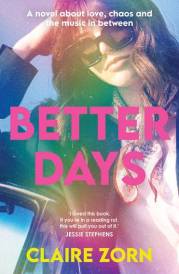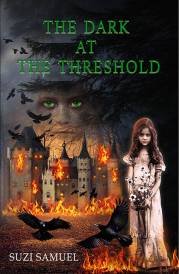Claire Foy Unsane
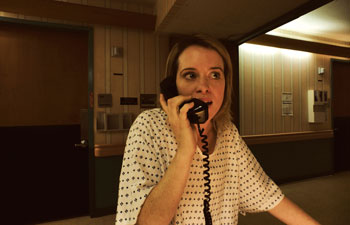
Warning: Contains Spoilers
Cast: Claire Foy, Joshua Leonard, Jay Pharoah
Director: Steven Soderbergh
Genre: Horror, Thriller
Rated: MA
Running Time: 98 minutes
Synopsis: Making a startling trip into thriller territory with Unsane, director Steven Soderbergh plunges audiences into the suspense and drama of a resilient woman's (Claire Foy, The Crown) fight to reclaim her freedom even as she risks her own sanity.
Scarred from the trauma of being stalked, quick-witted Sawyer Valentini (portrayed by Ms. Foy) has relocated from Boston to Pennsylvania for a new life. As her mother Angela (Academy Award nominee Amy Irving) misses her back home and her office job is hardly an ideal employment opportunity, Sawyer remains on edge following her two years of being terrorized. To consult with a therapist, she goes for follow-up treatment at the Highland Creek Behavioral Center. Sawyer's initial therapy session at the suburban complex run by clinician Ashley Brighterhouse (Aimée Mullins, Stranger Things) progresses well " until she unwittingly signs herself in for voluntary 24-hour commitment.
Unable to leave the premises, Sawyer finds herself in close quarters with previously committed hellion Violet (Juno Temple, The Dark Knight Rises) and savvy Nate (Jay Pharoah, Saturday Night Live), who is battling an opioid addiction. Sawyer expects to be out of Highland Creek within hours. But once she catches sight of facility staffer George Shaw (Joshua Leonard, The Blair Witch Project), she is terrified and then enraged…
…because she is convinced that Shaw's real name is David Strine and that he is her stalker. But is it real or is it a product of her delusion? As none of the doctors and nurses believe she is in danger, and all question her sanity, Sawyer's stay at Highland Creek is extended indefinitely. Sawyer realizes that in order to survive she will have to battle her demons and fight her way out.
Unsane
Release Date: April 25th, 2018
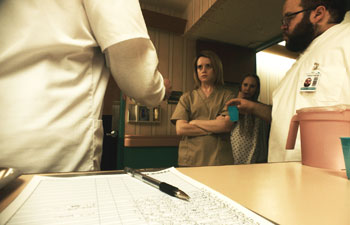 About The Production
About The Production
Is she or isn't she?
That is the question bedeviling the heroine of director Steven Soderbergh's new thriller Unsane, which will provide audiences with chilling moments.
Viewers will find the experience doubly disturbing, since the movie's contemporary setting and concerns render it, notes Steven Soderbergh, 'as a genre story rooted in the real world, and in something that's possible; the chances of this happening to you are quite plausible. Thematically, that links Unsane to other films I've made."
It is also linked to projects that Steven Soderbergh has helmed which center on a woman urgently taking agency in a life-defining situation, including the Oscar-winning Erin Brockovich and the action-packed Haywire. He comments, 'I've always believed that the mere act of having a female protagonist makes any story more dramatic; they have obstacles to overcome that men don't always have to deal with.
'I've also always been on the lookout for stories with female leads that allow for the exploration of why things are much more difficult for them. With a male lead, the stakes in our movie would not be as high and the level of vulnerability would be lower. In the culture that we occupy, the weight given to something a woman says is different than that given to something a man says " which plays into the central idea of Unsane."
And so Sawyer Valentini, facing her fears, clings desperately but firmly to her belief that she is sane even as she is being told otherwise…
The Hunt of the Thrill
By late 2016, Steven Soderbergh was in post-production on his first feature film in several years, the heist comedy Logan Lucky. His next movie, he hoped, would be something quite different. He remembers, 'I had pretty much decided that I did want to go back to making feature films, but I wanted them to be " if at all possible " genre films. I was putting in place a method of distribution, Fingerprint Releasing, that is ready-made for such projects.
'In the first week of January 2017, I got a call from [screenwriter] James Greer, whom I've worked with before. Jim wanted to know if I had anything in the hopper for him to be part of. I told him, -No, I don't, unfortunately. But if you write a low-budget thriller, I'll shoot it this summer.'" It was equal parts creative dare and handshake deal. Steven Soderbergh offers, 'If there's not something about a project that scares me a little then I know it's probably not good to do. For this, it was going to be the speed we were going to have to maintain; a genre I hadn't worked in before; and the intent to make the movie with technology that I hadn't used before in anything other than as a hobby."
For Greer and his screenwriting partner Jonathan Bernstein, who have been working together over nearly two decades, 'the story came about while Jonathan and I were having one of our idea sessions on Skype. We had been working on writing genre tales that weren't high-budget. Near the end of this session, Jonathan Bernstein e-mailed me an idea he had about a woman who is involuntarily committed into a mental institution, based on an actual account we'd read, and is locked up with her own stalker. I forwarded this one sentence to Steven and he responded immediately. Suddenly I was telling Steven Soderbergh that we would have a script for him within a couple of weeks."
Jonathan Bernstein recounts, 'We started writing, emphasizing to each other how this was a story that could happen to the viewer; this is a situation you could find yourself in. We had a screenplay 10 days later."
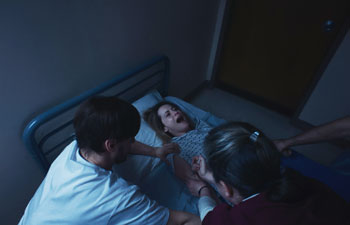 James Greer concurs, stating that 'earlier in our careers, we ran up against being told -Women don't open movies, rewrite it for a male.' But Jonathan Bernstein and I tend to gravitate towards female characters as protagonists and in this case, it grew naturally out of the premise and the article we had read."
James Greer concurs, stating that 'earlier in our careers, we ran up against being told -Women don't open movies, rewrite it for a male.' But Jonathan Bernstein and I tend to gravitate towards female characters as protagonists and in this case, it grew naturally out of the premise and the article we had read." As they were writing a movie set largely in a confining locale, Jonathan Bernstein noted that the team couldn't help but 'talk about classic mental hospital-set films. We discussed Shock Corridor and One Flew Over the Cuckoo's Nest. Sometimes you're stealing and you don't know you're stealing!" Reading the script, Steven Soderbergh too found himself 'cognisant of what had worked in the thriller genre; I thought of Repulsion and Rosemary's Baby. I made a list and rewatched some films " including ones set in more contemporary times " and I realised that ours should be more about intensity and discomfort than overt horror violence.
'Throughout the script, the writers were very respectful of the tropes that exist in these kinds of films but they placed them in the interesting context of what is going on now in the health care industry. I quickly said to them, -We're going to start shooting June 1st.'"
As Steven Soderbergh prepared to staff up Unsane with cast, crew, and production personnel, he found himself 'intrigued by the possibility of being a different director, while doing this movie, than I had been before " to the point where I had a meeting in March 2017 with a Directors Guild of America officer in which I proposed the idea that I would have a pseudonym as director, for not only Unsane but also for what I envisioned as a series of projects like it. I said, -Well, I want to free myself from my own name and to go make choices that I wouldn't normally make, treating this as an exercise in developing another directorial personality.' It would be like how authors create alter egos for themselves and publish under different names; it was a legitimate request and, I didn't think, an unreasonable one.
'The talks continued but it became clear to me that the guild ramifications going forward could be a bridge too far for the DGA. I realised I didn't want to burn too many calories over this, because what I needed to be doing was focusing on how I would be shooting the movie."
Taking the Lead
With the start date locked in, Steven Soderbergh 'began having conversations with Carmen Cuba, our casting director.
'For the role of Sawyer, what put Claire Foy on my radar was not The Crown but rather her acceptance speech at the 2017 Golden Globe Awards; she was obviously so surprised and unprepared, and made no attempt to disguise that. I found her, in that moment, to be completely charming and that's what made me go and watch The Crown, which I liked. I thought, -Well if she's that different in real life, maybe she's willing to be different for a part like this in a movie like this.'"
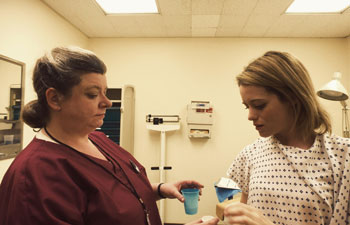 Steven Soderbergh asked Cuba to arrange a meeting with Claire Foy. This would, they found, necessitate the director's flying to London. Once he got there for the sitdown, he 'talked with Claire Foy for three hours.
Steven Soderbergh asked Cuba to arrange a meeting with Claire Foy. This would, they found, necessitate the director's flying to London. Once he got there for the sitdown, he 'talked with Claire Foy for three hours. I gave Claire Foy the script and described just how this movie was going to be made " and told her I wanted to keep it as far under the radar as possible. She was agreeable to that.
'It was clear that she was excited about the possibility; this was such a 180-degree turn from The Crown. Like me, Claire Foy saw Unsane as something fresh to do."
Foy confirms, 'At that point in my life and my career, it was exactly what I wanted to do! The character of Sawyer was much more expressive and emotive, and wilder, than I had played before.
'I thought some parts of the screenplay trod the line of being funny and hideous at the same time. Unsane is a cautionary tale, for all sorts of reasons. The element of mental health, and how we take care of people or don't take care of people, in the Western world was a part of the concept that interested me and Steven Soderbergh as well."
With Claire Foy on board, new work on the script was occasioned. Greer reports that 'the finished movie hews pretty closely to what we first wrote. But one character was added in, partly because when Claire Foy first read the script, she felt that the stalking elements and the presentation of the character of Sawyer's stalker David Strine weren't scary or omnipresent enough.
'Also, Steven Soderbergh came up with a new ending that we then went ahead and wrote, and which is in the final movie. He also asked for a monologue-to-camera for Strine, which we wrote and which is what now opens the movie."
The changes enhanced the lead character and sparked Foy's portrayal. Producer Joseph Malloch says, 'Claire Foy has the great ability to draw any audience in. This was important because we meet Sawyer after she's been through a traumatic experience; we're starting our journey with her as she's trying to restart her own life."
Portrayals that resonated with Claire Foy as she shaped her characterization around the script's path for Sawyer included one that she is 'in awe of: Jack Nicholson in One Flew Over the Cuckoo's Nest. You feel the blood pumping in his veins; he is so alive, dangerous, and unpredictable " and kind of unreliable as a protagonist, so you wonder what to believe about him.
'Jimmy Stewart in Rear Window was so good at playing obsession and paranoia " and at playing distraught, which was behavior I had to do full-time in Unsane."
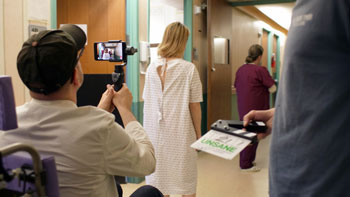 Claire Foy ultimately honed in on how 'Sawyer is a resilient person. She is strong physically, and is very clever. But she's sort of an unfinished person " which is a weakness and a strength. While this can leave her vulnerable, by the end of the movie she is on her way to who she really is. 'Steven Soderbergh liked the hard edges of Sawyer, how she was deeply hurt as a kid and has kept people away. He wanted her not to be a conventional central character."
Claire Foy ultimately honed in on how 'Sawyer is a resilient person. She is strong physically, and is very clever. But she's sort of an unfinished person " which is a weakness and a strength. While this can leave her vulnerable, by the end of the movie she is on her way to who she really is. 'Steven Soderbergh liked the hard edges of Sawyer, how she was deeply hurt as a kid and has kept people away. He wanted her not to be a conventional central character." The casting process continued as, for the pivotal role of David Strine, Cuba brought Joshua Leonard to Steven Soderbergh's attention. The actor read the script and was impressed at 'how the story plays around frighteningly with the nature of perception, with how different the filter that we all see our lives through can be " given one's past history and immediate circumstances.
Bernstein confirms, 'We didn't want David to be a horror-movie villain. The phrase we had in mind was -the banality of evil.' It's all the more disturbing that there's this bland guy and then you find out what he really is."
The actor considered the screenwriters' character-detailing at length. He notes, 'Sawyer is coming out of a very traumatic past to start her life anew. He fixates on the notion that they should be together, that she's the primary component which has been missing from his life. In approaching the role, the way I related to him was to think about all the times in my own life where I've convinced myself that if I get something then I will feel complete: a job, a bank account amount, and so forth. David has had something missing in himself, but rather than try to fix himself from the inside out he became convinced that Sawyer was the solution. So her trauma follows her across state lines.
'What I found out through personal conversations is that what Sawyer faces is prevalent; when I told close female friends that I would be portraying a stalker, I heard stories of what had happened to them. It is overdue that these are now becoming public conversations rather than private conversations."
Greer says, 'As we've seen in the world recently with women coming forward to tell their stories, Sawyer has to face people discounting her believability. We look at what that would do to one's selfconfidence, when no one around you believes you."
Steven Soderbergh comments that 'because ours is a genre movie, we depict extreme acts, but we also explore what it's like to now have trust issues."
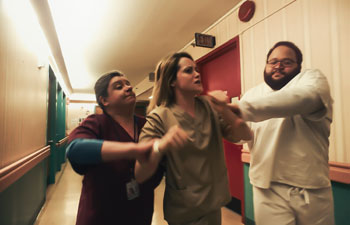 Adding the one character to the screenplay became a way to further explore Sawyer's altered reality and also to impact the audience. How this character's sequence unfolds will come as a surprise to the viewer.
Adding the one character to the screenplay became a way to further explore Sawyer's altered reality and also to impact the audience. How this character's sequence unfolds will come as a surprise to the viewer. 'I was speaking to an actor whom I've worked with before about how I was going to be making Unsane," recounts Steven Soderbergh. 'This actor said, -Is there anything for me in it?' I thought about what place my friend could have in the project. I called Jim and suggested a flashback scene where someone explains to Sawyer what her life will now be like, how it is changed, because she is being stalked.
'Through the course of my career, I have worked with colleagues who have encountered people with dark and violent intentions. Recalling these, we started doing research, including having conversations with security people on some of my past projects, to craft a monologue for this added character. We wanted to get as much real information into two-and-one-half minutes as possible. This would be a crucial moment for Sawyer."
Steven Soderbergh says, 'The scene became one of the scariest in Unsane, because it's about how there is no going back once someone has invaded your life; Sawyer knows she is now subject to this possibility. That's key to understanding Sawyer's responses in the timeline of the story that follows."
Foy notes, 'I read and watched as much as I could to gain insight into people's experiences of being stalked. As a woman, I understood the fear. But, unless they've been through it nobody can ever understand what that does to you psychologically; in a lot of the accounts I read, there was the element of starting to believe the hold a stalker has on you. That is demoralising and terrifying."
Malloch adds, 'We didn't embellish much on the stalking front. The reactions we've gotten from people who have seen the finished film speak to how unsettling it is because the story is relatable to so many women."
Steven Soderbergh reports, 'I had given the book that is shown in the flashback sequence to my daughter when she was in high school, saying to her that I felt she should read it. She gave copies to her classmates."
The Hospital
Although the Unsane filmmakers were aware from their project's inception of the cinematic lineage of classic thrillers and genre fare, the production soon became embedded in another moviemaking tradition: an actual setting where art could imitate life and where cast and crew would be suitably unnerved.
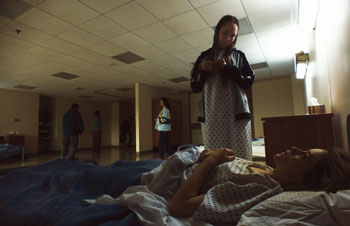 As screenwriter Greer reveals, the Highland Creek facility called for in the script came to have the real-life benefit of 'a disused hospital serving as the filming location."
As screenwriter Greer reveals, the Highland Creek facility called for in the script came to have the real-life benefit of 'a disused hospital serving as the filming location." 'I wanted Unsane to be made on and at existing locations," explains Steven Soderbergh. 'I've worked with our location manager Robert Striem for years and years. [Production designer] April Lasky had not been a department head before, but she had held enough positions of responsibility that I felt she could handle this " and April turned out to be a great addition to the team."
Lasky reports, 'That we were going to be shooting 80 percent of the movie in one location, a mental hospital, seemed challenging but fun. I was excited to work with Steven and his usuals; Michael Jortner,
the prop master, has done I think all of Steven Soderbergh's movies and was a good person to bounce ideas off of. I couldn't have asked for a better movie to work on as my first major feature, with a support network of experienced crew members."
Steven Soderbergh notes, 'For the design of Unsane, we were working backwards from what existed in the facility that we were shooting at. There wasn't enough money to modify the location in any significant way, including painting it. The good news was that there turned out to be an interesting, unusual palette existing in the hospital. This facility had such a distinctive approach to its walls and wallpaper, as if research had been done into a color scheme that would -relax' people. I liked the fact that it wasn't a typical scary locale, but the reality of this facility made for a strange place for us to be in " which totally worked for our movie.
'You could see how and where and when it had been abandoned. You would walk into offices and it was clear that people had been told, -Get up from your desk, leave this building and never come back.' There were papers piled around, folders out, coffee cups still sitting there, tear-off calendars where the day was up."
Lasky confirms, 'Apparently, they had had to shut down in the middle of the day; people just left their desks. If we moved something from one area to another " including to dress [Highland Creek clinician] Ashley Brighterhouse's office " then we would have to later put it back exactly where we had found it. There were important legal documents left out that we had to conceal, yet couldn't touch. The mental hospital is shut down; it's been closed down for years but a small portion of it is still running, as a nursing home."
Lasky remarks, 'The wing we shot in has not had patients for a number of years, but a lot of the rooms had furniture. The space we used for the large main ward " where the Highland Creek nurses keep an eye on the patients " had dozens of wheelchairs sitting in it that we had to haul out; we brought in metal frame twin-size beds, night stands, and overhead fluorescent fixtures that mount to the walls. That was the largest location we had to dress.
'When reading the script, Girl, Interrupted came to mind. But our location wasn't the traditional mental hospital; it was more of a regular hospital. It had more of a -90s look to it, not the -60s architecture we think of from those movies. In Unsane, the behavioral facility is supposed to be operating a bit under the radar. My team and I worked to make it look more like a drug rehab facility; we thought about which items patients could or couldn't have with them. All lighting had to be in the walls; picture frames had to be bolted down; and televisions couldn't be portable."
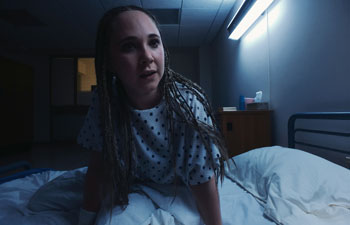 The eerie nature of the abandoned sectors had to be shaken off by Lasky's unit. She says, 'Some of the area was now just shells of what had been there, so we would be dressing them for a purpose they had already served. The nurses' station desk was still there but we had to fill it with medical files, computers, and phones " some of which we found elsewhere in the hospital. Everything had to looked lived-in again, including the break room."
The eerie nature of the abandoned sectors had to be shaken off by Lasky's unit. She says, 'Some of the area was now just shells of what had been there, so we would be dressing them for a purpose they had already served. The nurses' station desk was still there but we had to fill it with medical files, computers, and phones " some of which we found elsewhere in the hospital. Everything had to looked lived-in again, including the break room." Although the main ward was the biggest location, the most critical one as called for in the script was the padded cell where Sawyer faces her worst fear. Lasky fortunately found out from 'one man who had worked at the hospital that there was a behavioral health center portion; there was an existing padded room that we wound up using for the movie. We had to add padding to the floor to match what was already on the walls, because the entire room needed to be padded for the scenes."
This pre-existing space was 'very small and very creepy " perfect for Unsane" and did date back further. There was only the one door, and there was a window " which for our scenes we had to cover up. For the scenes in there it would be at most Steven Soderbergh, his camera assistant, a stunt safety supervisor, and the actors; everyone else would be standing by, outside the doorway."
The facility held one last surprise for the filmmakers. Steven Soderbergh reveals, 'What we didn't know is how striking it looked from the air " until our drone cameras took footage. We got the shots we needed and then the crew brought the drone back down and said to me, -Take a look at this.' 'I hadn't realised, from ground level, how the place sticks out like a tooth in the landscape. It looks creepy and isolated; we got lucky again."
Close Up
As the shooting schedule in June 2017 loomed for Unsane, the pre-production process continued apace for actors and crew. That it went precisely according to the initial plan set forth back in January is a testament to the excellent working relationships that Steven Soderbergh has fostered with his core production unit.
He comments, 'On Unsane, everyone was really doing more than one job " which is, or should be, part of the fun of it. There were opportunities for people to move up and take on more responsibility than they have had before, but in a context where the scale of the project was more concentrated."
Even before Steven Soderbergh gave that opportunity to production designer April Lasky, he minted a new producing partner. He says, 'Knowing Joe Malloch as I do, I felt this was the perfect project for him to step up to produce on and become the person that he's been mentoring under, Michael Polaire, who I've been working with for a long time. My working relationship with Joe on this went well enough that we are planning another project of a similar scale."
The project also intrigued another veteran of Steven Soderbergh's projects. He remembers, 'I called Susan Lyall to ask her if she knew someone who might be a good candidate to become a department head as costume designer on Unsane. She said, -I don't understand why I can't do it,' and I said, -It's a small movie and a short shoot; it would be you and a couple of other people.' She still wanted to do it." Lyall would work closely with Lasky to coordinate the palette for the extended Highland Creek scenes.
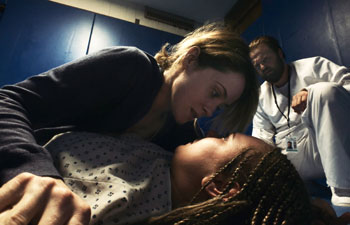 The cast, paradoxically, would be almost entirely comprised of actors that the director hadn't worked with prior. Steven Soderbergh found that 'from our earliest discussions, these were actors excited to try something different in making this movie. Juno Temple was someone whose work I've been watching for a while. However, I said to her, -Juno Temple, your hair is a national treasure, but I need you to take it off the table; is there anything you can do to remove it as a character?' She responded, -Well, I've always wanted to get cornrows.' I told her -Great, go ahead,' and I think Juno liked having it not be a part of who this character was. It's such an extreme look for her; it was like telling Jack Nicholson he can't smile. She took the directive and ran with it, showing up for the shoot ready to play Violet pretty much exactly as you see her in the movie."
The cast, paradoxically, would be almost entirely comprised of actors that the director hadn't worked with prior. Steven Soderbergh found that 'from our earliest discussions, these were actors excited to try something different in making this movie. Juno Temple was someone whose work I've been watching for a while. However, I said to her, -Juno Temple, your hair is a national treasure, but I need you to take it off the table; is there anything you can do to remove it as a character?' She responded, -Well, I've always wanted to get cornrows.' I told her -Great, go ahead,' and I think Juno liked having it not be a part of who this character was. It's such an extreme look for her; it was like telling Jack Nicholson he can't smile. She took the directive and ran with it, showing up for the shoot ready to play Violet pretty much exactly as you see her in the movie." Juno Temple confirms, 'Steven wanted me to be almost unrecognisable in Unsane. Doing Violet's hair in cornrows was a great way to help me to create the character; make-up, hair, and wardrobe all are very important for embodying one. Violet constantly fiddles with her hair, using it as a weapon or armor. When she walks into a room, she wants people to know it's her."
When Sawyer finds herself held at Highland Creek, Violet has already been confined there for a while. Juno Temple explains, 'Violet -welcomes' her by trying to be the boss. My character is a young woman who is unstable and needs care and help. She's from West Virginia, and is -white trash' I guess. She was very repressed back home and deeply wants to be loved by people. But whenever she has reached out, it has turned into her having to fight for survival; Violet has had to fend for herself through violence, although I would say that she's more of a danger to herself than to others around her."
Beyond taking on the challenge of the character, Temple was drawn to the urgency of the story. She says, 'My heart rate went nuts when I read the script. Unsane is about being trapped in a situation where nobody will believe the truth, which heightens the feeling of captivity. The scenario of not being heard and not being listened to? There have been so many examples of this in the current climate, and what Sawyer goes through is one of anyone's worst nightmares. I knew Steven wouldn't glamorise the uncomfortable nature of the story. In today's society, people have their phones out all the time, filming everything; everyone can be a Peeping Tom. Sawyer has been watched in a way that's not at all romantic, loving, or kind.
'As the story unfolds, we see how the system is failing Sawyer because she is being held against her own will with someone she knows is a danger to her and to others. The powers of authority are very quick to call her crazy, and that's also about money; it's a bureaucracy and not a conspiracy, but it's an abuse of power."
Steven Soderbergh delves further into this component of the plot, recounting that 'Sawyer has a history of mental health issues, and is candid with a health care professional " which triggers activity for a system that profits in the short term from having people enter it on the terms it's set up. The question is, does this approach benefit people who need help or does it benefit large health care companies? They make money off of what are, in a way, incarcerations.
'Maybe Highland Creek is working for other people, but it doesn't work for Sawyer. The key turn here comes with a boilerplate -patient document' that Sawyer doesn't bother to read all of " as most of us wouldn't " but there is a sentence in it that ultimately comes as a surprise to her, and her reaction to that guarantees she will be sucked into a vortex. As she talks more, the hole just gets bigger and bigger. The conversations Sawyer has with the people assessing her are, to me, terrifying."
Getting a handle on the Highland Creek context for her clinician character, Aimée Mullins comments, 'Sawyer goes there trying to stabilise her life. But once a therapist uses legal authority to check her in for the one-week observational stay, Sawyer's raging against the machine that is holding her against her will gives them enough -bad behavior' proof to justify their treatment of her.
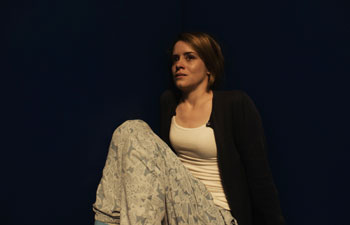 'My character, Ashley Brighterhouse, is climbing the corporate ladder. She runs Highland Creek with an iron fist in a velvet glove, and she believes that people really do leave her institution better off than when they came in. She feels completely justified in her choices. Steven and I both felt strongly that she believes in her mission to make Highland Creek a success. She is driving herself forward in typeA ways that perhaps don't consider the repercussions of some of her business strategies."
'My character, Ashley Brighterhouse, is climbing the corporate ladder. She runs Highland Creek with an iron fist in a velvet glove, and she believes that people really do leave her institution better off than when they came in. She feels completely justified in her choices. Steven and I both felt strongly that she believes in her mission to make Highland Creek a success. She is driving herself forward in typeA ways that perhaps don't consider the repercussions of some of her business strategies." Rounding out the cast inside Highland Creek is Jay Pharoah. Carmen Cuba had recommended the actor to Steven Soderbergh, who recognised him from his years on Saturday Night Live. The director and screenwriters realised that Pharoah's improvisational skills would be put to good use to enhance the characterization of fellow patient, Nate.
Pharoah offers, 'When Steven Soderbergh calls you and says he has a part you'd be perfect for, you don't hesitate to do it. He said he felt I could pull off the dramatic side of the character, who is the smartest person in the ward at Highland Creek. He also told me to just play it as real as possible, which gave me the context on where to go performance-wise.
'His direction made things feel natural for our amazing cast; going back and forth with the dialogue in my scenes with Claire, I would forget we were reading lines, and Juno and Josh were phenomenal."
Juno Temple says Pharoah is 'brilliant and fluid in his scenes. He was so good at having his character showing people what he wants them to see."
Joshua Leonard praises the contingent formed around him for the Highland Creek denizens to be 'a fantastic set of characters. With Juno Temple and Jay and Aimée together, it's an unlikely group of people yet it all feels very much of a piece and makes sense."
The sole main cast member who stays largely on the outside of Highland Creek was also the only one with whom Steven Soderbergh had worked before; 17 years after making the multi-Oscar-winning Traffic together, the director sought out Amy Irving for another collaboration, asking her to portray Sawyer's concerned mother, Angela Valentini.
The Academy Award nominee remembers, 'Steven Soderbergh called me while I was in Spain and said, -I'm like a locust, Amy; every 17 years I come out and offer you a movie.' Steven is incredibly gifted as a director, and is sensitive to an actor; I'd never forgotten what it felt like on Traffic, having the director right there with the camera and his eye on you. He creates an atmosphere on the set where you're there to find your truth and be the best that you can be. That's an actor's playground.
'He said this that shoot would be no make-up and hair person, no lighting, no dressing rooms, no drivers, no nothing; he was inviting me to be part of an experiment. Who better to do one with?" Steven Soderbergh offers, 'Amy is at a point in her career where there has to be something about the project that intrigues her. Right before we started shooting, she said, -It's funny. I'm as anxious about going to work as when I was 19.'
'That surprised me, yet it is probably what makes her continue to be so alive on-screen. And I understood, from my own experiences; if you're not anxious, you're probably complacent." Irving feels that 'this story brings up all sorts of emotions about women in terrifying situations, trying to deal with them." Her presence in Unsane, and her on-screen daughter's fight for survival, will put moviegoers in mind of Irving's classic thrillers Carrie and The Fury. She reveals, 'I know I started my career with those, but " I don't like getting scared at the movies! I only go to them if I'm in them…"
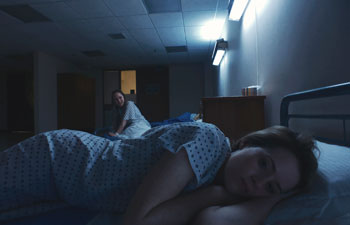 Making a personal connection to her character, Irving sees Angela as 'the mom that everyone would like to have if they were facing this; she drops everything when she hears that her child is in peril, and will do whatever she has to do.
Making a personal connection to her character, Irving sees Angela as 'the mom that everyone would like to have if they were facing this; she drops everything when she hears that her child is in peril, and will do whatever she has to do. 'When Angela gets that phone call, it's almost like she can't take in what's being said, hearing about the oppressive situation that her daughter is in; she just jumps in a car and goes to help."
The swift shooting schedule and compact camera work led to what Irving remembers as 'my favorite part of the shoot " getting lost with Steven, when we were filming a driving sequence. We weren't -lost in Yonkers,' but, nearby. He had the iPhone ready but we couldn't find a smooth road. It gave us time to connect and to catch up.
'We eventually returned to base camp and he got a kind of shock absorber, a miniature Steadicam handle that he'd bought for $35. So we got back in the car, he held the iPhone in that, and we were able to do the scene."
The components of the shoot complemented one another, says Temple, explaining that 'because of fewer crew and equipment around, the iPhone created a greater intimacy as you would sometimes forget it was there. It could be put into places that would make the scenes up close and personal " like on Claire Foy's face."
Given the unobtrusive nature of the camera, Foy muses that 'there was no separation; it felt like Steven Soderbergh was watching.
'There were New York theatre actors cast to play the other patients in the background. So you had a whole world of entire life stories going on; Steven gave everyone free rein to invent and create their characters."
Juno Temple affirms that the director gave 'us a lot of freedom to roll with our characters; it didn't matter whether you were on or off-camera, the idea was to stay in character. For the scenes with all the patients, this certainly helped us feel that we were among characters with their own psychoses; you'd see things out of the corner of your eye, and the camera would too."
Greer marvels, 'There are things you can do with it that could never be done with a regular camera; one day, Steven strapped it to Claire Foy's back for a scene where Sawyer is being dragged down the hall. 'The shooting days weren't particularly short," muses Greer. 'But they weren't longer than on a regular-length feature shoot; you just got a lot more done. There was no waiting around, which I know is one of an actor's least favorite things to do. Steven has done this for so long, and he's done it so well, that he knows when he's got what he needs and then it's, -moving on.'"
Steven Soderbergh allows, 'I think we only had one 12-hour day; these were normal shooting days. I knew the schedule was going to be tricky but, based on the technology and what I'd gone through on The Knick and Mosaic, I felt we could do it. A day of shooting is the most expensive part of the budget of a production like this one; Unsane ended up costing almost exactly what my first feature sex, lies, and videotape cost."
Claire Foy remarks, 'Steven Soderbergh gets everyone on the same page, going back to the basics of being filmmakers and storytellers in the best way you possibly can."
Irving confides, 'People who work with Steven Soderbergh know what they're doing, which meant this set was efficiently run; so much is added onto film shoots that you don't really need! Pampering is not necessary; I loved that we didn't have to sit in a make-up chair. You felt more involved, more in the nitty-gritty of the work than -show business.' We got there each day and we would get busy; things just moved."
Foy adds, 'It was exciting to follow your instincts and dive straight in. Making this movie wasn't a marathon, it was a sprint."
Pharoah remarks, 'Steven Soderbergh knows when he has a good shot, so a bigger camera crew wouldn't matter. The man has the eye, and he is super-quick."
Leonard, a director himself, adds admiringly that 'being the underachiever that he is, Steven Soderbergh shoots all day and then edits all night. Claire Foy and I got a chance to watch a full-length cut of Unsane " on the night of the wrap party! We went bowling and celebrated, and Steven Soderbergh sat in the corner and worked on his laptop. As the evening was winding down, he came over to Claire Foy and I and said, -If you want to come by my room, I'll show you guys the movie.' So we had the opportunity to watch it that night; it was without the sound design or color correction, yet the edit was astonishingly close to the movie in its completed form."
Greer opines, 'I don't think Steven Soderbergh ever sleeps when making a movie. He'd be on the set between 8 and 8:30 AM, and shooting would start around 9 and would wrap between 7 and 9:00 PM. Then he would immediately start editing until around 12 midnight. From then until 4:00 AM he was ready to show footage to anyone who was awake. You'd stumble out of the editing suite " and he'd go on speaking with one of the actors until 6 in the morning. Then he turns up on the set fresh as a daisy and goes for another 12 hours."
Bernstein concludes, 'There might be two of him."
Technological Advance
With the cast and filmmakers having developed and completed Unsane in relative secrecy, advance discussion of the movie has centered on the technology with which it was made. With the movie finished as hoped and planned, the director can demystify the process in the hopes that other filmmakers will make use of the tools that he availed himself of. The film was written, shot, cut, and scored with Apple technology.
Steven Soderbergh remarks that 'having Unsane be described as -the iPhone movie' is certainly not something I feel embarrassed about or defensive about. Sean Baker's movie Tangerine, which I loved, was a seminal film that let people know where this technology was heading.
'I've been experimenting for years with this equipment, with these phones and with the lenses that are available to put onto these phones. I knew I would, at some point, make a movie with this technology because I looked at it as the future. It was also my intention that the resulting movie be one that any person can go into a theater and watch " and have no concept of what it was shot on, or care, because it looks like a normal film."
Starting with the basic names and numbers, Steven Soderbergh states that 'the phone Unsane was shot with was an iPhone 7 Plus, of which we had three. That phone is a 4K [digital] capture, so when you show that on a big screen it looks great because of the resolution. We used an app called FiLMiC Pro that allows for extra layers of control over the camera in terms of exposure: shutter speed, color temperature, focus. FiLMiC Pro also has a remote version, so if I put the lens somewhere that doesn't allow me to see the phone screen I still can remotely " on another phone " control all of those things.
'The iPhones are light, so they are sensitive to vibration. So for those overhead drone shots of the hospital facility that we needed, we could not use the 7 Plus; the phones could not be mounted on drones because they would shake too much and the image would buckle. The drones already had cameras as part of them, mounted inside."
Steven Soderbergh notes, 'the lenses were very small, too, and they came from a company named Moment. We used three that they make; one is an 18mm, one is a 60mm, and one is a fisheye. I had three sets of each lens ready in case I wanted to use them on three cameras at the same time, which I never did.
The 18mm was pretty much our default lens. On occasion, I would just use the lens that was in the iPhone itself if it was the right focal length for what we were doing."
He muses, 'I embraced using more wide lenses and having actors closer to the lens than I typically would " and all of this was part of throwing away what Steven Soderbergh would do. It was, what is the -director of Unsane' going to do? I just went with it, and it was really fun. There were many times during a day when I was setting up a shot and thought to myself, -Oh, I would never do that.' Even without the alternate directorial name, I'm looking forward to an active conversation about what I did go off and do."
Utilising the technology to the fullest also reduced the production's carbon footprint and kept within very modest budget parameters. Steven Soderbergh assessed 'the ripple effect that takes place when you can make a film with a crew this small, and it's all positive. This is a movie that was made with a truck and two vans, basically. Except for the shooting days when we had a lot of extras, our on-set presence was about a dozen people. That was the way we could execute Unsane properly at this scale. I wonder who will be the first filmmaker to shoot something that's not low-budget with a camera this small." Speaking of which, he continues, the entire 'camera department fit into a backpack; there were the three phones, all the lenses, extra batteries, onboard monitors, slates, microphones, and the DGI Osmo stabilising device."
Joseph Malloch adds, 'We had all the equipment we needed for Steven to successfully execute his vision; our biggest logistical challenge with regard to the camera department was not misplacing the package…"
During the editing process, the director was satisfied with all that he had been able to capture on the set. He reflects, 'What I was hoping to achieve was a level of liberation in staging that is only possible when you have a capture device that is this small; you can place the camera lens anywhere you can think of in a matter of seconds. That was a big -get' the experience provided, and made me excited about doing it again very soon; the freedom was palpable.
'I've shown Unsane to director friends who have taken note of what could be gotten by putting the lens anywhere, whether in a room or a car; they can feel the energy that comes from being able to move that quickly. Going forward, there are going to be certain filmmakers that see the benefits of having a camera small enough to place wherever you want it without any danger to the camera or to the people around it."
Then too, he admits, 'To paraphrase a saying: it's not the size of your chip, it's what you do with it. If you don't know how to stage, and shoot, and cut, it doesn't matter how big your camera is."
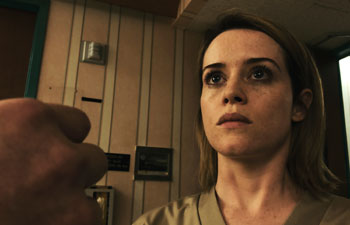 The Blue Room and Beyond
The Blue Room and Beyond Even as the technological and creative elements for Unsane were coalescing, all concerned were particularly intent on having everything be on point for the scenes that called for Sawyer and David to confront each other.
The padded cell which April Lasky and her unit had firmed up into an even more nightmarish setting than it already was had been dubbed 'the blue room."
Steven Soderbergh states, 'The blue room scenes were the meat of Unsane, thematically and narratively " and I'm glad that our writers were secure enough to go deep in their belief in the characters and the story, writing scenes which would run several minutes. As people know from the beginning of my career with sex, lies, and videotape, I'm very happy to film two people talking in a room; at a certain level, it's how the world functions."
Jonathan Bernstein comments, 'We were both surprised at how the blue room scenes played out. I wasn't prepared for the intensity of how it felt for Sawyer with her utilizing survivor's logic." James Greer adds, 'I was on the set for those scenes being shot, and heard [outside the door] what was going on. But when you see the way Claire Foy and Josh Leonard play them, and the way Steven shoots them, each of the sequences is a tour de force."
Josh Leonard remembers, 'One of the padded-room scenes was about eight pages long [in the script] and the other one was six or seven. We were supposed to shoot one on a Tuesday and then the other on a Wednesday."
Instead, notes Steven Soderbergh, 'We shot both of the sequences in the blue room with Claire Foy and Joshua Leonard on the same day. This was because we got through them so quickly, from the rehearsing and blocking to the shooting.
'It was exciting having to distill my staging ability down to its essence. Building it section by section, we ran through the scenes, letting them tell me what triggers their next actions as the conversation turns. For the scene where Sawyer wakes up in the middle of the room, Claire Foy is in there first so my question was, where did she want to be? She said, -Well, if anybody is coming through that door " especially David " it's about keeping as much distance as possible.' So we situated her in one corner where she would then quickly get to another corner. Claire Foy told me that Sawyer would want to make herself small and far away, and I agreed. Then the question for Joshua Leonard was on David's reaction to how Sawyer won't come closer to him. He responded that David would try to keep his distance for a while yet slowly work his way towards her. So then it was Claire Foy's decision of whether Sawyer moves again…But my approach to blocking is, if I can, to never get into an intellectual discussion; I try to keep it all physical."
Joshua Leonard reveals that at one point, 'Claire Foy and I did have to excuse ourselves for about 45 minutes and cram, figuring out how we were going to play it. Working at that pace was both liberating and petrifying."
Steven Soderbergh made sure 'that the amount of time between camera or lens setups was quick enough that they could stay -in it.' For those scenes, it was almost like doing a short play. I feel that's an ideal way to work."
Greer marvels, 'They got through it incredibly well. It was shot in the middle of a hot summer day, with no air-conditioning because that would have made too much noise. That intensity is reflected in what you see.
'Claire Foy brought depth to the characterization " and yet when Steven Soderbergh called -cut' she could snap out of being Sawyer and be joking around with cast and crew. I'd watch Claire Foy with Juno Temple doing heavy-duty scenes together in straight-up American accents and then be laughing over some obscure British joke."
Irving reports, 'Claire Foy is very earthy and sweet " and she fell in love with my dogs, which endeared her to me for life."
Steven Soderbergh reveals, 'Claire Foy, on day one of filming, had to shoot both the beginning and the end of the film. We had to calibrate the characterisation of Sawyer properly so it wasn't -We had her at 7 and she should have been at 10' or vice versa. Claire Foy's instincts were accurate as to pacing herself for the final scene; she does so much with her face.
'She brings out the mixture of dread and hope we experience wondering what is going to happen to Sawyer. This is a woman in a desperate situation and at critical points, she sees an opening that she can exploit. I like the ambiguity of that. She acts the way she does not out of a moral choice but because if she does not act she will be killed."
'There are so many shocking moments," says Claire Foy, noting that anyone seeing the movie should 'expect the unexpected. It's old-school genre about something modern."
Unsane
Release Date: April 25th, 2018
MORE


